Sony. Nintendo. Microsoft. Google. Amazon. Walmart. Verizon. Electronic Arts. Nvidia.
Each of these companies are giants in their respective fields — and every single one of them is or is said to be testing tech that could change the way video games are played, distributed, and sold.
Some companies have announced publicly — while others are quietly experimenting behind closed doors. But each company is at least hedging against a future where discs, downloads, even consoles are no longer required, because you’ll stream games across the internet as easily as you stream your favorite Netflix show.
It’s called cloud gaming, and it’s not actually a new idea: Over the past decade, the tech’s been laughed at time and again due to technological and economic constraints. But this time, it feels like the stars may have finally aligned to bring cloud gaming to the world.
WHAT IS CLOUD GAMING, EXACTLY?
Today, you slide a disc into your game console, or download a game’s files onto a drive. Your game only looks as good and only runs as fast as the processors inside your box.
With cloud gaming, that “box” lives in a datacenter full of servers, miles and miles away. You stream games, just like you’d stream a YouTube or Netflix video, as a series of compressed video frames — only now, those videos are reacting to your inputs. Every time you press a button for your character to jump, that input gets sent to a remote server, tells the game what you’ve done, and sends you a new video frame that shows you the result. Multiply by 30 or 60 frames per second, and you’ve got a video.
THAT SOUNDS… DIFFICULT. DOES ANY OF THAT ACTUALLY WORK?
Yes! And not only in the lab. We’ve been testing early cloud gaming solutions in the US, Europe, and Japan for almost a decade now, and it’s only getting easier to play games that don’t actually run on a box in front of you. One Verge editor has pledged to beat the notoriously difficult Sekiro: Shadows Die Twice using nothing but game streaming services, and he’s already halfway through.


